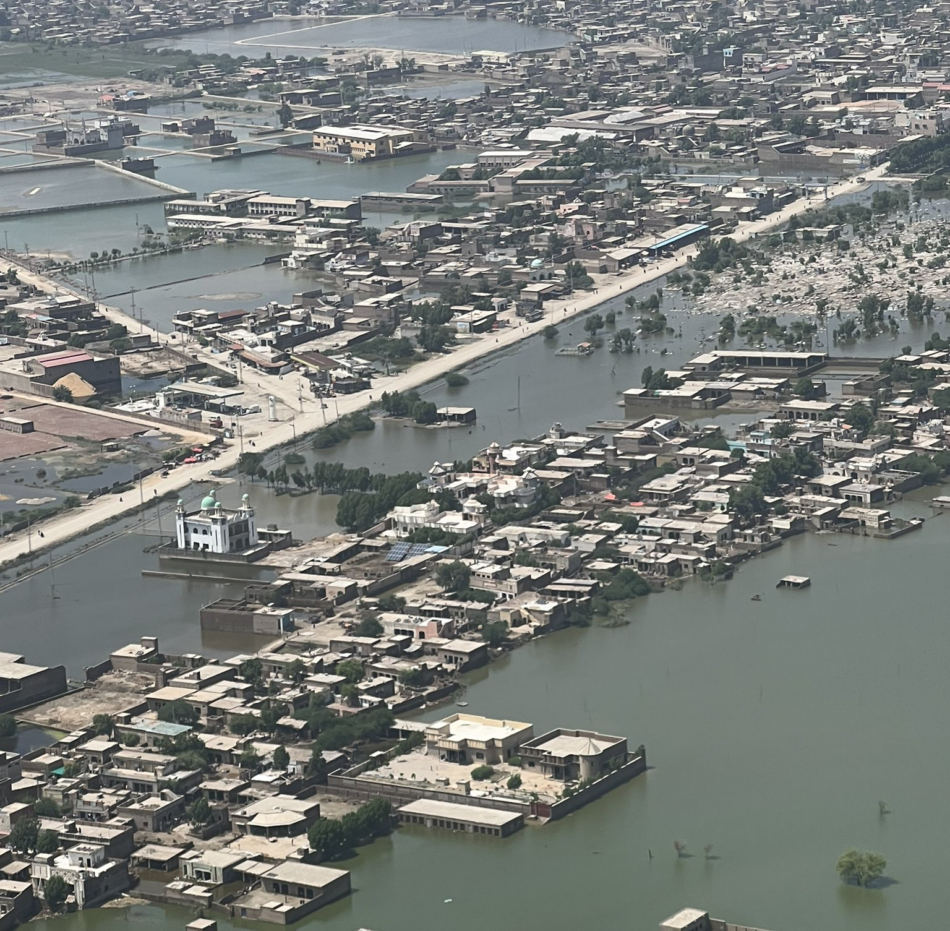Displacement is a major impact of the climate crisis in Pakistan. In a flood emergency access to the ‘digital ecosystem’ provided by mobile devices can be critical for individual safety, but not everyone has equal access, explain IWMI’s Kanwal Waqar and Alan Nicol.

Pakistan’s devastating losses from recent disastrous floods and droughts can be measured nationally in percentages of GDP, but in more human terms in displacement, insecurity and loss of livelihoods at a local level. Hundreds of thousands of people have suffered in Punjab and Sindh Provinces recently and ongoing research by the International Water Management Institute (IWMI) under the CGIAR Initiative on Fragility, Conflict, and Migration is examining the role played by ‘digital ecosystems’ during these events.
This network of social media, communications and internet connectivity is increasing in many daily lives, including information exchange, social connectivity and money transfer as well as other services. During Pakistan’s recent devastating floods between 2010 and 2023—with frequency appearing to be increasing—communities along riverbanks in Punjab and Sindh Provinces have often been forced to seek temporary safety on higher ground and away from floodplain areas, including moving to government-designated safe zones. Whilst this represents a level of adaptation capacity on the part of communities, it also leads to immediate food insecurity as well as long-term disruption to agricultural production. For women, in particular the poorest, additional concerns surround their immediate personal safety, hygiene, and healthcare during and after these events.
When fleeing rapidly rising water levels, households leave behind many of their belongings, especially those 20-30% who receive little or no notice, including missing important announcements made by local mosques, the most traditional form of communicating an evacuation. What people rarely leave behind, however, are their mobile phones and during and subsequent to a flood crisis these can be essential tools in sustaining household livelihood security because they provide an immediate gateway to a digital ecosystem of information exchange, government push notifications and a social network of dispersed community members. This may be via simple SMS messaging in local languages or using internet access on smarter devices.
As the head of the household, I manage all the household affairs. However, my son is the one who owns a mobile phone since our cultural norms discourage me from having one.
Female widow flood affected migrant, District RYK
It is noticeable, however, that access can be heavily genderized, with women frequently prohibited by men of their household from using mobile phones. These (male-imposed) cultural and social restrictions can severely impede women’s access to information and reduce their capacity to communicate to other members of the displaced community, or more widely, including to ensure their own personal safety.
Generally, this is an extension of pre-existing societal norms with young women on the whole not allowed to use their devices in rural areas. Economic hardship exacerbates the situation, since it is harder for communities to afford basic food and shelter in a situation of displacement, with education (and therefore literacy) seen as a luxury, especially for young girls. This alone can help to reinforce levels of digital exclusion that women face.
After the floods of 2022, the Government of Pakistan began using social media to help sustain the entire disaster management cycle (DMC), from rehabilitation through risk reduction, mitigation and relief. These communication channels have been used by local authorities, government agencies, and non-governmental organizations (NGOs) to spread important information including evacuation orders, flood warnings, and information on relief efforts.
Emergency services are using SMS and social media to immediately convey and magnify public emergency warnings. However, a notable gap in this entire approach is the absence of gendered access to information, significantly amplifying the vulnerability of approximately half of all affected individuals.
I don’t own an Android smartphone; I only have a simple mobile phone. Unfortunately, I haven’t been receiving any alerts through calls. I’m unable to read SMS messages.
Male, flood affected migrant, District RYK
In urban settings, more young women and girls in schools or colleges have access to smartphones, and while their male household members are around can use social media. This rural-urban divide is indicative of urban cultures changing and challenging conventional thinking and education. Most serious flood impacts, however, are felt in remote regions, where people are struggling with poverty and educational obstacles including illiteracy, which prevent women in particular and the elderly from requesting assistance during an emergency. Many of these people are unable to use mobile phones or to recognize numbers even.
The stark challenge of this digital divide has two key implications: first there is a risk that unless it is addressed now, digital inequality may become part of ‘normalized insecurity’ in an increasingly climate-insecure Pakistan. And, second, for any DMC to really work effectively, access to the digital ecosystem must be made available on a more even footing. In a sense, therefore, the climate crisis demands an acceleration in change and should trigger even greater efforts at tackling fundamental gender inequalities across the country. The severity of the climate crisis facing Pakistan’s remote rural communities in Punjab and Sindh demands no less. The irony that social media is ubiquitous across Pakistan, but not across individual households has clear implications for the success—or not—of future disaster response and risk reduction.
Bios
Kanwal Waqar – Researcher – Gender and Youth Specialist
Alan Nicol – Principal Researcher – Politics of Water, Climate Change and Migration

